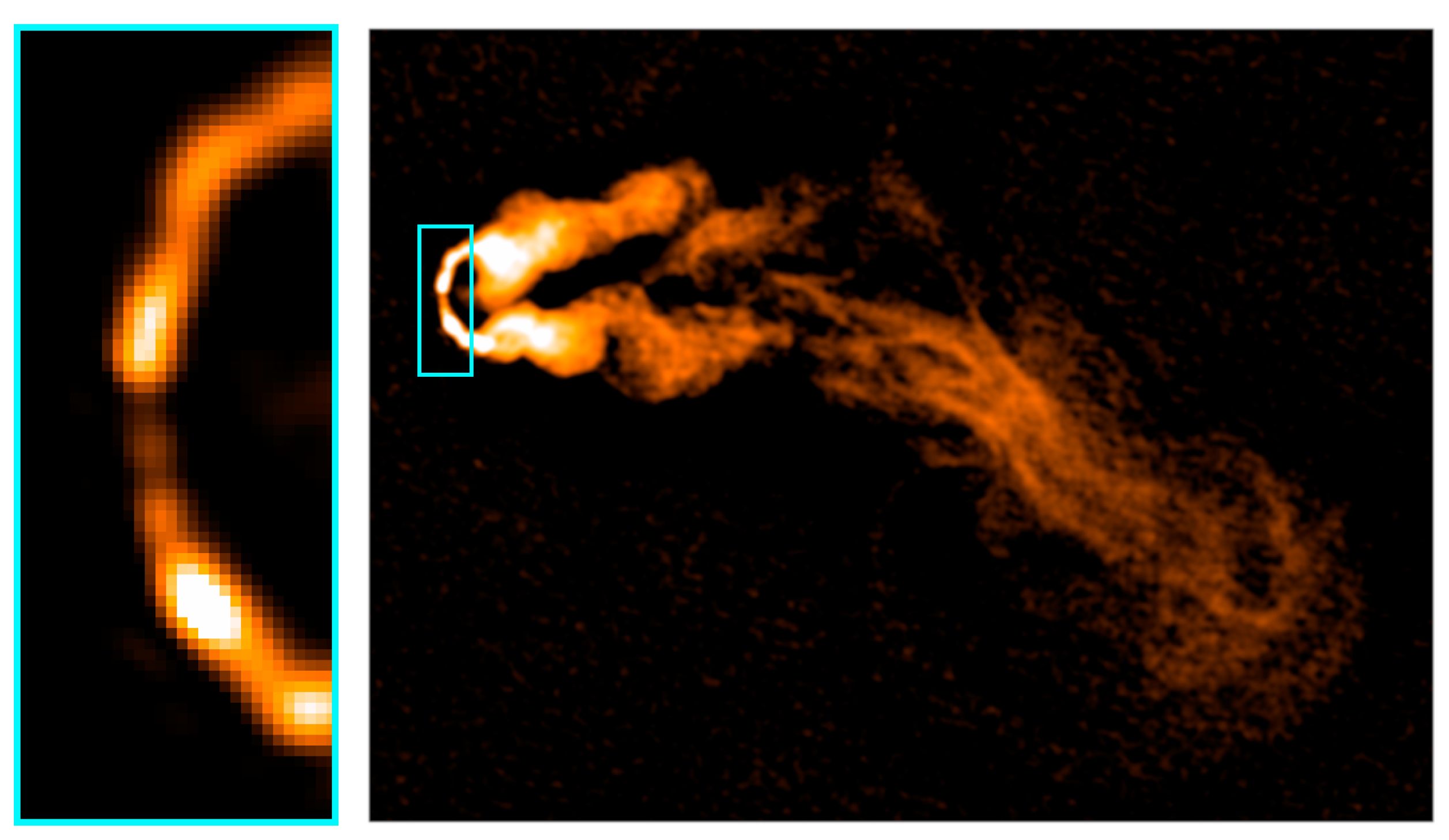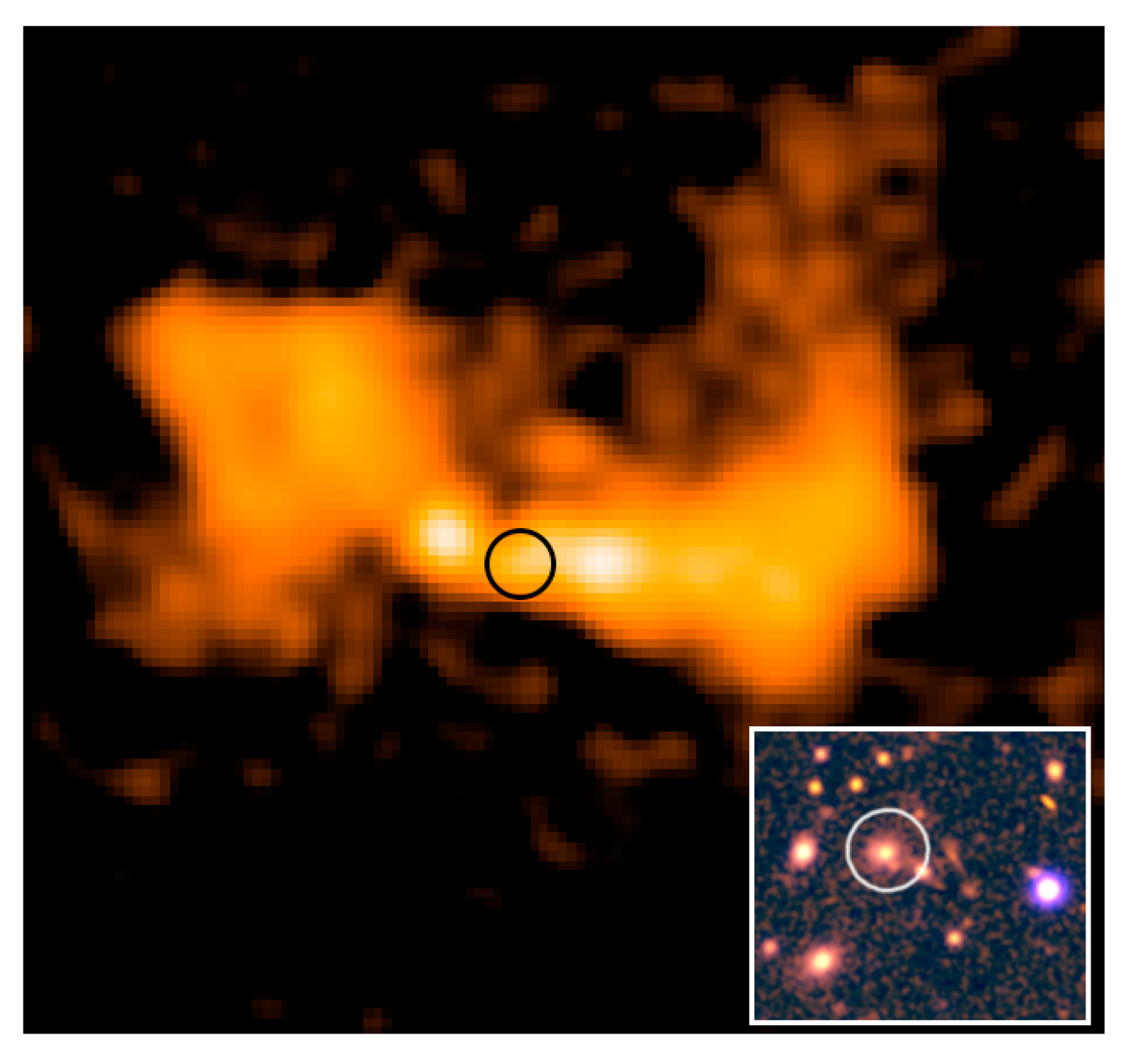Radio Galaxy Classification: #Tags, Not Boxes
Abstract
:1. Introduction
- Communication: For such purposes, we have a language to describe what objects we are interested in, “I’m investigating one-sided jets”.
- Investigation: For such purposes, we can define samples for study, e.g., to look for correlated variables, “I’m studying whether one-sided jets appear more frequently in variable core sources”.
- Interpretation: For such purposes, we can develop physical models to explain observed phenomena, “I’m working on how relativistic beaming can determine whether jets would appear one- or two-sided”.
- The current classification schemes are confusing and have started to break down.
- As a community, we want to document a very wide variety of characteristics for large samples of radio sources. Some of the more commonly mentioned ones (at least today) are listed in Table 2.
- Multi-wavelength information should be included where available.
- Confidence levels should be provided.
- Classifications should evolve as more information becomes available.
- The criteria for classification should be completely transparent.
2. #Tags
2.1. #Tag Principles
- #Tags as proposed here apply to sources, where all emissions are believed to originate in a single host, whether it is visible or not. #Tags currently do not apply to the source’s constituent components, as identified by “source” finders, although such schemes could also be developed.
- Each source can have multiple #tags.
- A source can pass or fail meeting the criteria of each #tag or it can have insufficient information to be tested. For example, a barely resolved double source cannot be tested for the number of jets present.
- There can be multiple versions of #tags for the same purpose, with different underlying criteria. For example, #Giant might include bent sources, where the sum of the length of the two lobes was >700 kpc, while #Giant might only include sources that cannot fit in a 700 kpc box.
- #Tags must be based on well-defined criteria that are quantitative wherever possible, with the definitions or algorithms made available.
- #Tags can change with time as more information or better algorithms become available. (Keeping track of versions will become important.)
- #Tags should have corresponding confidence values if possible.
- #Tags will be specific to a given survey since they will depend on resolution, sensitivity, dynamic range, availability of auxiliary information, etc.
- #Tags can be valuable even when they appear trivial. For example, although sizes and errors may be included in a catalog, the distinction between extended and compact sources may need expert judgement and be embodied in the #tag. The experts would consider the dependencies on signal:noise, dynamic range, the presence of artifacts, etc., in setting up #tag criteria.
2.2. Tag Example
2.3. Implementation of #Tags
- For a source-based #tag scheme, the components from source-finders will first have to be assembled into sources, with or without host identification.
- Each #tag will require measurements or other data about the source that are already included in the catalog. Early identification of #tags to be used will ensure that the required information is available.
- While some #tags will be based on catalog data, other #tags will require algorithms to be run on images (e.g., symmetries, jet presence, or dominance)
- Some #tags will require information from auxiliary databases not included with the catalog; links or other references with respect to that information are needed.
- All criteria and algorithms should be made publicly available either as metadata or in software repositories, etc.
- Different surveys will require different schemes; however, wherever common definitions can be used, those will be highly desirable.
- It is desirable to allow for new #tags developed by individuals and teams to be added to the catalog after appropriate vetting by the survey team.
- Versioning of #tags will have to be built into the catalog design.
3. Conclusions
Funding
Institutional Review Board Statement
Informed Consent Statement
Data Availability Statement
Acknowledgments
Conflicts of Interest
References
- Hardcastle, M.; Croston, J. Radio galaxies and feedback from AGN jets. New Astron. Rev. 2020, 88, 101539. [Google Scholar] [CrossRef]
- Owen, F.; Rudnick, L. Radio sources with wide-angle tails in Abell clusters of galaxies. Astrophys. J. 1976, 205, L1–L4. [Google Scholar] [CrossRef]
- Gendron-Marsolais, M.; Hlavacek-Larrondo, J.; van Weeren, R.J.; Rudnick, L.; Clarke, T.E.; Sebastian, B.; Mroczkowski, T.; Fabian, A.C.; Blundell, K.M.; Sheldahl, E.; et al. High-resolution VLA low radio frequency observations of the Perseus cluster: Radio lobes, mini-halo, and bent-jet radio galaxies. Mon. Not. R. Astron. Soc. 2020, 499, 5791–5805. [Google Scholar]
- Knowles, K.; Cotton, W.; Rudnick, L.; Camilo, F.; Goedhart, S.; Deane, R.; Ramatsoku, M.; Bietenholz, M.; Brüggen, M.; Button, C. The MeerKAT Galaxy Cluster Legacy Survey. Astron. Astrophys. 2021. accepted. [Google Scholar]
- Banfield, J.K.; Wong, O.I.; Willett, K.W.; Norris, R.P.; Rudnick, L.; Shabala, S.S.; Simmons, B.D.; Snyder, C.; Garon, A.; Seymour, N.; et al. Radio Galaxy Zoo: Host galaxies and radio morphologies derived from visual inspection. Mon. Not. R. Astron. Soc. 2015, 453, 2326–2340. [Google Scholar] [CrossRef] [Green Version]
- Williams, W.L.; Hardcastle, M.J.; Best, P.N.; Sabater, J.; Croston, J.H.; Duncan, K.J.; Shimwell, T.W.; Röttgering, H.J.A.; Nisbet, D.; Gürkan, G.; et al. The LOFAR Two-metre Sky Survey. III. First data release: Optical/infrared identifications and value-added catalogue. Astron. Astrophys. 2019, 622, A2. [Google Scholar] [CrossRef] [Green Version]
- Krawczyk, C.; Masters, K.; Lingard, T.; Smethurst, B.; Kruk, S.; Lintott, C.; and Many More from Galaxy Zoo Team. MaNGA Morphologies from Galaxy Zoo. Available online: https://www.sdss.org/dr16/data_access/value-added-catalogs/?vac_id=manga-morphologies-from-galaxy-zoo (accessed on 1 October 2021).
- Davison, W.; Parkinson, D.; Tucker, B.E. STag: Supernova Tagging and Classification. arXiv 2021, arXiv:2108.10497. [Google Scholar]


| Category | Classes |
|---|---|
| Morphology | Double; Classical double; Triple; Narrow-angle tail; Wide-angle tail; |
| Bent-tail; FRI, FRII, FR0 *; Hybrid; X-shaped; | |
| S-shaped; C-shaped; Relaxed; Dying RG; Double-double; | |
| Core-dominant; Core-halo; Core-jet; CSO; 1-sided | |
| Size | Compact (pc); Galactic (<10 kpc); extended RG (10–1000 kpc); |
| Giant RG (>1 Mpc) | |
| Host | Radio Galaxy; SFG: Spiral; Seyfert I,II; QSO; Blazar |
| BLLac; BLRG; NLRG; ULIRG; LERG; | |
| HERG; LINER; BCG | |
| Spectra | Flat; Steep; Ultra-steep; GigaHz Peaked; |
| Inverted; Convex; Concave; Complex |
| Category | Measurements/Descriptors |
|---|---|
| Direct | Peak and total flux; Brightness temperature; |
| Angular size and area; Linear Size and area; | |
| Redshift; Spectral index; Fractional polarization; RM; | |
| Number of components/peaks in source | |
| Structural | Core/total flux; Number of jets (0, 1, 2); Jet-flux/total-flux; |
| Peak-separation/total-extent (FRI,II); Shape (e.g., linear, bent); | |
| Symmetry (S-, C-, X-) | |
| Supplemental | Host properties (include SFR); X-ray properties; |
| pc-scale structure; group or cluster environment |
| #Tag | Value | #Tag | Value |
|---|---|---|---|
| Structural | Spectral+ | ||
| #EMK:S-symmetry | +1 | #EMK:SteepSpec | +1 |
| #EMK:C-symmetry | −1 | #EMK::ConvexSpec | 0 |
| #EMK:FRI (peaksep/tot < 0.5) | +1 | #EMK:Backflow | −1 |
| #EMK:FRII (peaksep/tot > 0.5) | −1 | #EMK:Outflow | +1 |
| #EMK:Coredom | −1 | #EMK:Polarized | 0 |
| #EMK:Giant | 0 | #EMK:BCG | 0 |
Publisher’s Note: MDPI stays neutral with regard to jurisdictional claims in published maps and institutional affiliations. |
© 2021 by the author. Licensee MDPI, Basel, Switzerland. This article is an open access article distributed under the terms and conditions of the Creative Commons Attribution (CC BY) license (https://creativecommons.org/licenses/by/4.0/).
Share and Cite
Rudnick, L. Radio Galaxy Classification: #Tags, Not Boxes. Galaxies 2021, 9, 85. https://doi.org/10.3390/galaxies9040085
Rudnick L. Radio Galaxy Classification: #Tags, Not Boxes. Galaxies. 2021; 9(4):85. https://doi.org/10.3390/galaxies9040085
Chicago/Turabian StyleRudnick, Lawrence. 2021. "Radio Galaxy Classification: #Tags, Not Boxes" Galaxies 9, no. 4: 85. https://doi.org/10.3390/galaxies9040085
APA StyleRudnick, L. (2021). Radio Galaxy Classification: #Tags, Not Boxes. Galaxies, 9(4), 85. https://doi.org/10.3390/galaxies9040085






